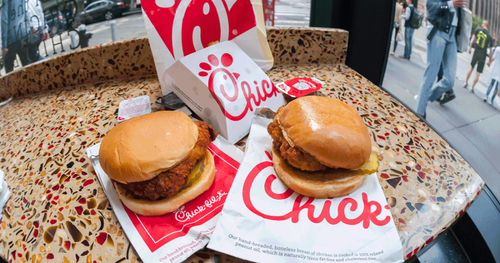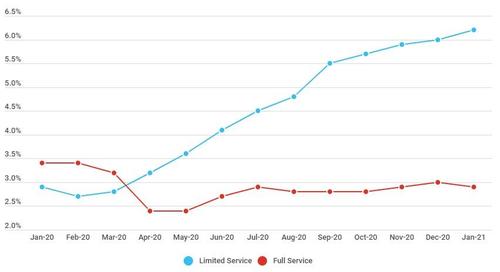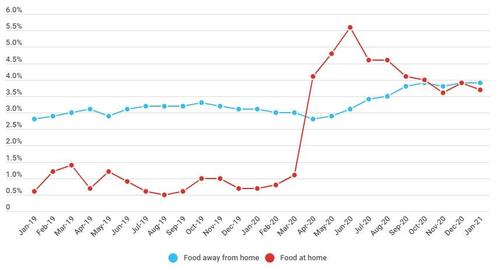Fast-Food Menu Prices Have Soared During The Pandemic
Authored by Jonathan MAze via RestaurantBusinessOnline.com,
The pandemic has apparently led to higher prices for fast food.
In January, prices for food away from home—or menu prices—increased 3.9% year-over-year. That was the same rate as in December. That is also the highest rate for menu price inflation since late 2008, when the country was in a deep recession.
But these menu prices aren’t evenly spread. Much of that abnormality can be traced to a certain type of restaurant: One without wait staff.
According to federal data, prices at limited-service restaurants increased 6.2%. By contrast, prices at full-service restaurants increased 2.9%.
What’s more, the gap first began to open in March of last year—when states closed dining rooms around the country. Check out this graphic:
Limited service menu prices v. full service
Prices at counter-service restaurants began increasing at higher rates starting last March.
Source: U.S. Bureau of Labor Statistics
The difference can likely be explained in two words: Demand and wages.
In the post-pandemic era, demand at limited-service restaurants has far exceeded demand at full-service restaurants. While the supply of full-service restaurants is constrained because of limitations on seating and the closures of a number of locations, what’s left of that business hasn’t necessarily been all that eager to take pricing dramatically higher, lest they lose customers.
Quick-service restaurants haven’t had that problem. Delivery, drive-thru and takeout all became vital in the post-pandemic world. Consumers lined up for blocks at Chick-fil-A drive thrus and ordered delivery at three times the rate they did in the previous year.
That tends to result in higher prices because operators, not worried about losing that business, felt free to raise prices. And consumers are loaded with cash and not spending it on anything else.
Check out what happened to grocery prices during the depths of the pandemic:
Grocery price inflation v. restaurants
Food at home inflation took off during the pandemic and was double what it was at restaurants.
Source: U.S. Bureau of Labor Statistics
But many fast-food operators felt they had little choice but to increase prices because of the other influencer—wage rates. By all accounts, operators at fast-food restaurants we speak with describe challenges getting workers, which has driven up wages—as has wage-rate increases at big retailers like Target, Walmart and Costco.
To match those higher wages, fast-food restaurants have raised prices. Full-service restaurants haven’t had that problem because much of their staff rely on tips.
It’s also possible that delivery prices are influencing these numbers. Several restaurant chains have either fully implemented or are in the process of implementing premium prices for third-party delivery orders. Noodles & Co. just increased its premium by a third and those prices are now 15% higher. Chipotle customers pay 13% higher prices on the base price for third-party delivery food.
Buffalo Wild Wings, Wingstop, Popeyes, Chick-fil-A, Wendy’s and several other fast-food chains charge higher prices on third-party delivery orders.
Fast-food chains are better able to take these steps than full-service restaurants, many of which are small chains and independents that aren’t often allowed to raise prices for third-party delivery.
The result of all this is that a fast-food delivery meal is now about the same price as a lower-end full-service restaurant meal. Earlier this month, we ordered delivery from Chick-fil-A for my family of four and the next day visited a local full-service Mexican restaurant.
The price, after the tip, was about the same for both visits.




Comments
Post a Comment